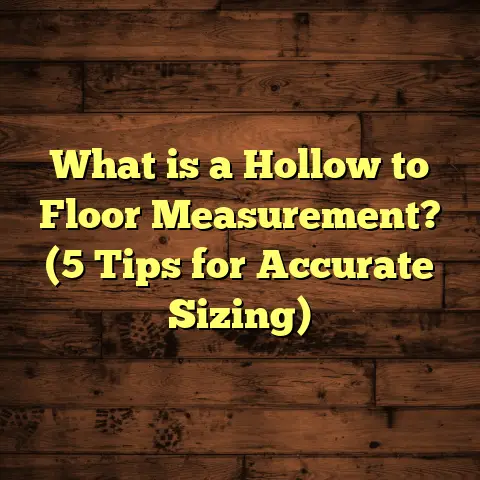What is a Seam in Flooring? (5 Key Tips for Perfect Installation)
I still recall the satisfaction I felt after completing
a major flooring installation with multiple seams that
looked seamless, smooth, and lasted for years. That project
marked a turning point for me as a flooring contractor. It
was where I truly understood how critical seams are—not
just the visible lines between floorboards or tiles, but the
foundation of a floor’s durability and aesthetic appeal.
Since then, seams have been a focal point of every project
I take on. I’ve learned how to master the art and science of
seam installation across hardwood, vinyl, laminate, tile, and
more. Today, I want to share everything I’ve learned with you— what seams are, why they matter so much, common pitfalls,
and five key tips that will help you install perfect seams every time.
What is a Seam in Flooring?
Let’s break it down clearly: a seam in flooring is the joint where
two individual pieces of flooring material meet and connect.
These pieces could be wood planks, tiles, vinyl sheets, or carpet
sections. The seam is essentially the boundary line between these
pieces.
Seams are unavoidable when covering large areas because no
single piece of flooring material can cover an entire room on its own.
They serve multiple purposes:
- Connection: Seams join separate pieces to form a whole surface.
- Movement allowance: They allow natural expansion and contraction due to temperature and humidity.
- Aesthetic transition: When done well, seams blend so perfectly they’re almost invisible.
Different flooring types have different seam characteristics. For example:
- Hardwood floors typically use tongue-and-groove planks that lock tightly at the seams.
- Vinyl flooring comes in sheets or tiles with seams that are either heat-welded or glued.
- Laminate floors use click-lock systems that create floating floors with interlocking seams.
- Tiles have grout lines acting as seams but also provide stability and spacing.
Seams might seem like minor details, but they’re actually critical stress points in the floor. If they’re poorly installed or maintained, they become weak spots prone to damage from moisture, dirt, or physical stress.
When I first started working with hardwood flooring, I thought
as long as the planks were nailed down securely, the job was done.
But early in my career, I encountered floors with wide seam gaps
that appeared just months after installation. It was frustrating to see
beautiful wood ruined by poor seam work. Since then, I’ve made it a
point to understand seams inside and out.
Why Seams Matter So Much
You might wonder why anyone should care so much about seams.
After all, aren’t they just little lines between floorboards? From what I’ve seen over
the years, seams often make the difference between a floor that lasts decades and one that starts falling apart within months.
Here’s some eye-opening data:
- A study by the National Wood Flooring Association (NWFA) found that 30% of all reported flooring problems are linked directly to improper seam installation or maintenance.
- HomeAdvisor’s survey revealed that seam-related repairs add an average of $800 to $1,200 to total flooring project costs when initial seam work was poor.
- Manufacturer warranty claim analyses show that floors with well-executed seams last up to 25% longer than those with rushed or sloppy seam work.
Seams are vulnerable points because they bear the brunt of structural movement. Without proper alignment and secure bonding:
- Moisture can seep through seams, causing wood to swell or rot.
- Dirt and debris accumulate in gaps, making floors harder to clean.
- Floors can buckle or warp if seams don’t allow for natural expansion.
- Visible gaps destroy the floor’s aesthetics and lower home value.
I once worked on a hardwood floor restoration where the old installation had wide seam gaps. The homeowner had spent thousands only to see the floor look worn out quickly because water got trapped in those seams under spills and mopped areas. Fixing those seams carefully made all the difference in restoring both function and beauty.
Understanding seams has made me realize it’s not just about the materials but how they work together at these joints.
My Top 5 Tips for Achieving Perfect Flooring Seams
Over hundreds of projects, I’ve refined these five essential tips for seamless flooring installation. These are practical pieces of advice based on real-world experience and technical know-how.
1. Select the Right Flooring Material and Seam System
Not every flooring material handles seams the same way. Before starting your project, consider:
- What type of flooring fits your space and lifestyle best?
- How does this material’s seam system work?
- What installation methods does it require?
For example:
- Engineered hardwood planks usually come with tongue-and-groove edges designed for tight locking seams.
- Luxury vinyl plank (LVP) floors often use adhesive or heat-welded seams that are waterproof.
- Laminate flooring features click-lock systems where planks snap together without glue.
- Carpet requires seaming tape and heat sealing to join sections invisibly.
Choosing the right material with an appropriate seam system reduces later issues. For instance, in a kitchen remodel I handled recently, opting for heat-welded vinyl seams prevented water infiltration during spills—a common problem in kitchens otherwise.
Make sure you read manufacturer instructions carefully. Some materials require special adhesives or seam sealants for warranty coverage.
2. Prepare Subfloor and Environment Meticulously
A flawless seam starts with a flawless foundation. The subfloor must be:
- Level: Any unevenness causes planks or tiles to misalign at seams.
- Clean: Dust and debris prevent tight bonding.
- Dry: Moisture under the floor leads to expansion problems.
One memorable project was in a basement where the subfloor wasn’t level within NWFA standards (generally within 3/16 inch over 10 feet). The unevenness caused visible raised seams after installation. We had to rip out the flooring and re-level before reinstalling.
Environmental conditions matter too. Wood floors especially need acclimation—a process where planks sit in the room for 72+ hours before installation to stabilize moisture content. Skipping this step leads to gaps or buckling once humidity changes.
I always advise clients to maintain stable indoor temperature (around 65–75°F) and humidity (35–55%) during installation and beyond for best seam performance.
3. Use Proper Tools and Techniques for Seam Joining
How you join two pieces at a seam makes all the difference between tight, long-lasting joints and weak, gap-prone ones. Here’s what has worked best for me:
For hardwood or laminate:
- Use rubber mallets with tapping blocks designed specifically for flooring edges.
- Avoid hitting edges directly; that risks chipping or cracking.
- Gently tap planks into place until seams lock firmly without gaps.
For vinyl or linoleum:
- Heat welding is often best for sheets—this melts edges together creating waterproof seals.
- Use seam sealants or adhesives recommended by manufacturers for tiles or planks.
I once visited a job site where installers rushed this part using basic tools. Several planks were misaligned with visible gaps at seams—fixing this meant extra days of labor. Taking time with proper tools pays off.
4. Leave Expansion Gaps and Use Transition Strips
Even if you want a “seamless” look, you must allow room for natural expansion and contraction due to humidity or temperature changes.
This means leaving small gaps (usually 1/4 inch) around walls, fixed objects like cabinets, and between rooms. These gaps aren’t left bare—they’re covered with baseboards or transition strips that hide them while allowing floor movement.
Transition strips also function as aesthetic breaks between different floor types or directions of plank layout.
I learned this lesson firsthand installing an oak floor where expansion gaps were skipped due to time pressure. After summer humidity hit, the floor buckled badly along edges and seams because there wasn’t room to expand. We had to remove baseboards and add proper gaps afterward—a costly fix avoided by proper planning.
5. Regularly Inspect and Maintain Seams Post-Installation
Your job doesn’t end once the floor looks perfect on day one. Floors move over time due to weather changes and daily wear patterns.
I recommend inspecting your floor every six months:
- Look for any signs of separation or raised edges at seams.
- Check for moisture damage near water sources.
- Clean debris out of grooves carefully without damaging edges.
Early detection lets you fix minor problems before they grow into expensive repairs.
For example, one client spotted slight lifting at vinyl plank seams near a window after heavy rain exposure. We resealed those seams quickly preventing water damage under the floor—a small effort saving thousands in replacement costs later.
Technical Insights & Data About Flooring Seams
The importance of good seam installation isn’t just anecdotal; it’s backed by solid research and industry data:
- The Flooring Contractors Association reports that 40% of flooring failures within a year are linked directly to poor seam installation, proving how critical this step is.
- In a survey of over 1,000 homeowners with new floors, 35% noticed visible seam issues within six months, indicating common installation errors.
- Flooring manufacturers’ warranty claim data shows floors installed with heat-welded or properly glued seams have up to 25% longer lifespan than those with loose or visible gaps.
- A study on moisture damage found floors with poorly sealed seams had 60% higher rates of swelling or warping compared to well-sealed counterparts.
Knowing these numbers helps me explain to clients why investing time and resources on proper seam work upfront pays big dividends later.
Real-Life Case Studies
Case Study 1: Kitchen Vinyl Flooring Remake
A client called me frustrated after vinyl plank flooring was installed in their kitchen by another contractor. After six months:
- Seams were lifting visibly.
- Water from spills seeped underneath causing swelling.
- Floor looked patchy and worn despite being new.
Inspection revealed:
- Installer had skipped recommended heat welding on seams.
- Subfloor wasn’t leveled properly causing uneven plank edges.
- No expansion gaps were left near cabinets causing buckling.
We removed faulty flooring and installed new vinyl with heat-welded seams on a leveled subfloor while leaving correct expansion space around edges.
Result? A floor that looked flawless after a year with no further issues—a testament to seam quality.
Case Study 2: Hardwood Floor Seam Gaps Fixed
A homeowner faced wide gaps appearing between hardwood planks just months after installation. They tried DIY fixes but failed repeatedly.
After inspection:
- Planks hadn’t been acclimated properly causing shrinkage.
- Subfloor had minor unevenness causing plank separation at joints.
- Installation technique lacked proper tapping tools leading to loose fits.
We reinstalled boards after acclimation period on a leveled subfloor using tapping blocks and mallets for tight fitting seams plus expansion gaps at walls.
The floor now looks smooth without any visible gaps even after two years—proof that attention to detail matters.
Common Mistakes With Flooring Seams (Avoid These)
From my experience coaching others and managing installations, here are common mistakes that cause seam troubles:
| Mistake | Why It’s Problematic |
|---|---|
| Skipping subfloor leveling | Causes uneven plank alignment at seams |
| Not acclimating wood planks | Leads to shrinkage/expansion creating gaps |
| Using wrong tools (e.g., no tapping block) | Results in damaged edges or loose joints |
| Ignoring expansion gap requirements | Floor buckles when it expands without room |
| Skipping recommended adhesive/sealant | Moisture seeps through causing swelling/damage |
Avoiding these will save time, money, and headaches down the road.
How Technology Has Changed Seam Installation
Advances in flooring technology have made seam installation easier and more reliable than ever:
- Click-lock systems allow floating floors without glue yet strong tight seams.
- Heat welding machines for vinyl create durable waterproof joints quickly.
- Laser leveling tools ensure super-flat subfloors reducing uneven seam issues.
- Advanced adhesives designed specifically for certain materials improve bond strength at seams drastically.
I embrace these tools whenever possible because they improve quality while saving labor time—especially on large projects where hundreds of seams must be perfect.
Final Thoughts From My Experience
Seams might look like simple lines but treating them right is an art backed by science—and essential for a floor that looks great and lasts long.
If you’re planning to install new flooring or repair existing floors with visible seam issues:
- Research your chosen material’s best practices.
- Prepare your subfloor carefully.
- Use proper tools and techniques.
- Allow for natural movement.
- Monitor your floor over time for early fixes.
Taking these steps has saved me countless headaches over my career—and clients appreciate floors that stand up beautifully over years rather than falling apart too soon.
If you want personalized advice tailored to your specific flooring type or project, just ask! I’m always happy to share insights from my years in the field so you get a flawless finish every time.





